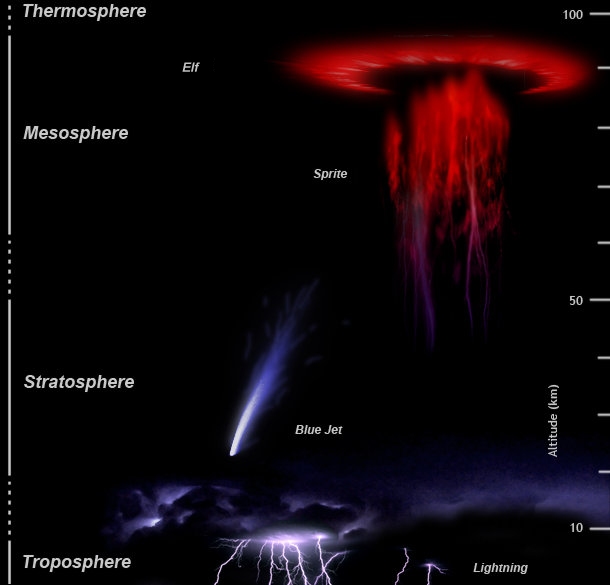https://en.wikipedia.org/wiki/Sprite_(lightning) wrote:
<<Sprites or red sprites are large-scale electrical discharges that occur high above thunderstorm clouds, or cumulonimbus, giving rise to a quite varied range of visual shapes flickering in the night sky. They are usually triggered by the discharges of positive lightning between an underlying thundercloud and the ground.
Sprites appear as luminous reddish-orange flashes. They often occur in clusters above the troposphere at an altitude range of 50–90 km. Sporadic visual reports of sprites go back at least to 1886 but they were first photographed on July 6, 1989, by scientists from the University of Minnesota and have subsequently been captured in video recordings many thousands of times.
Sprites are sometimes inaccurately called upper-atmospheric lightning. However, sprites are cold plasma phenomena that lack the hot channel temperatures of tropospheric lightning, so they are more akin to fluorescent tube discharges than to lightning discharges. Sprites are associated with various other upper-atmospheric optical phenomena including blue jets and ELVES.
Sprites are colored reddish-orange in their upper regions, with bluish hanging tendrils below, and can be preceded by a reddish halo. They last longer than normal lower stratospheric discharges, which last typically a few milliseconds, and are usually triggered by the discharges of positive lightning between the thundercloud and the ground, although sprites generated by negative ground flashes have also been observed. They often occur in clusters of two or more, and typically span the altitude range 50 to 90 kilometres, with what appear to be tendrils hanging below, and branches reaching above.[4]
Optical imaging using a 10,000 frame-per-second high speed camera showed that sprites are actually clusters of small, decameter-sized (10–100 m or 33–328 ft) balls of ionization that are launched at an altitude of about 80 km and then move downward at speeds of up to ten percent the speed of light, followed a few milliseconds later by a separate set of upward moving balls of ionization. Sprites may be horizontally displaced by up to 50 km from the location of the underlying lightning strike, with a time delay following the lightning that is typically a few milliseconds, but on rare occasions may be up to 100 milliseconds.>>
 Gigantic Jet Lightning over India
Gigantic Jet Lightning over India



